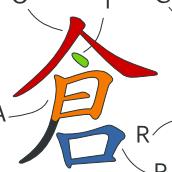One week with Cangjie Input (倉頡輸入法)
I decided to learn Cangjie Input Method recently. I often find myself in the situation where I need to look up the meaning and pronunciation of a Chinese word or character. But how can I type it into a dictionary using pinyin if I don't know the pronunciation? I usually find myself using a stylus on my tablet to draw the characters, or even using the mouse on a PC to draw the characters on screen. Worst case, I look up each character by selecting radicals. Having to draw or look-up the character slows me down so much when I'm really trying to focus on reading a passage, and I get less time to study and find I am spending a lot of time trying to input characters.
When I lived in Japan I once witnessed a typist inputing characters into an old type-setting machine. The typist was reading hand-written manuscripts and converting these manuscripts to a digital format. The typist could input any character with only a few keystrokes, it was amazing. The typist was so proficient with this system that she found using a phonetic-style IME on Microsoft Windows to be very frustrating. She complained of having to type and then select a choice from a list, where as on the type-setting machine she could look at a character and quickly get it on screen. Also, if she didn't know a difficult character, she could still type it without having to know the pronunciation for inputting the character. Of course she had to learn this typing system and I am sure that it took time to master.
Is it worth it to learn a non-phonetic based input system? Perhaps. I learned to touch-type when I was 15 and it changed my life. It took time and work, but it has paid off in many ways and was well worth the time investment. Perhaps Cangjie may offer a similar experience? Before committing to Cangjie, I looked into other systems, such as Wubi, but it appears that Wubi is only for simplified character sets (as I understand it). As primarily a student of Traditional characters, I wanted to learn a system that could do Traditional characters at a minimum. I also thought about a hand-writing based input system, which would be good for remembering how to write by hand, but I still think a keyboard is more practical.
The first week was good overall. There were some surprises to begin with. I'm working mostly from a Linux laptop with the Ibus input system. Unfortunately, the Cangjie plug-in for Ibus only supports characters used in Hong Kong, and as such it is not possible to input any simplified characters. Other Cangjie implementations allow this from what I have read, such as Twinbridge (which doesn't even appear to be in active development and is Windows only). I'll have to try out Cangjie on Mac OS X next to see how that goes. While this is not a show stopper for me, it is a bit inconvenient. I'll still have to use pinyin for when I need to type a Simplified character.
Learning Cangjie will clearly take time though. I memorized the 24 primary/main signs and practised typing some characters and words that can be input with a single or combination of the primary/main signs. Note: signs are like radicals...but not the same thing. Signs are character components that make up a complete character. From this point forward it is going to get hard though. The next step is to learn the secondary signs (80+), and then learn the rules for identifying the proper order and identification of the signs.
I hope to have more progress to report next week.



8 Comments
Recommended Comments